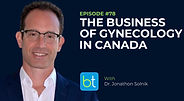BackTable / OBGYN / Podcast / Episode #80
Endometrial Ablation: Past, Present & Future
with Dr. Ted Anderson
Endometrial ablation has become a cornerstone procedure in the treatment of abnormal uterine bleeding, but is it the right solution for every patient that meets the indication? In this episode of the BackTable OBGYN Podcast, Dr. Ted Anderson from Vanderbilt University joins host Dr. Mark Hoffman to discuss the evolution of endometrial ablation and its contemporary utilization, including patient selection, technical considerations, and alternative treatments for abnormal uterine bleeding.
Be part of the conversation. Put your sponsored messaging on this episode. Learn how.

BackTable, LLC (Producer). (2025, March 25). Ep. 80 – Endometrial Ablation: Past, Present & Future [Audio podcast]. Retrieved from https://www.backtable.com
Stay Up To Date
Follow:
Subscribe:
Sign Up:
Podcast Contributors
Synopsis
Dr. Anderson begins by detailing the history of abnormal uterine bleeding alongside the evolution of the endometrial ablation techniques that have been used to treat it. Shifting focus to current day practice, he then shares his approach to endometrial ablation, covering patient selection and the technical aspects of his approach.
Throughout the conversation, Dr. Anderson emphasizes the importance of how we define success in endometrial ablation, explaining that eumenorrhea (normal bleeding that no longer interferes with life events) is the goal, as opposed to the more traditional view that amenorrhea is the target outcome. The episode closes with a discussion on the role of alternative treatments, such as the Mirena IUD and hysterectomy for abnormal uterine bleeding.
Timestamps
00:00 - Introduction
09:29 - History of Abnormal Uterine Bleeding and Endometrial Ablation
23:31 - Evolution of Endometrial Ablation Devices/Techniques
31:11 - Selecting the Right Patient for Ablation Success
34:38 - Post-Tubal Sterilization Ablation Syndrome
38:27 - The Role of IUDs in Managing AUB
44:07 - Reevaluating Endometrial Ablation Success Metrics
49:55 - Innovative Ablation Techniques: Cryoablation and Steam
51:48 - Adenomyosis and Fertility-Sparing Treatments
57:28 - Final Thoughts
Transcript Preview
[Dr. Ted Anderson]
Endometrial ablation fell out of favor for a number of different years until two or three things occurred in the 1920s, when we had the advent of the era of electrosurgery. This is when Harvey Cushing and William Bovey did all their experience and learned about how to use electricity to your advantage in surgery. Then the development of the resectoscope, which wasn't until 1989, actually. This was when Karl Storz had the combination of using the Hopkins rod lens and all the digital imaging. It brought hysteroscopy into play. Then, the advent of minimally invasive surgery in gynecology, which occurred in the 1980s.
When we started having all these things coming together, we saw a resurgence in the interest of intrauterine surgery, and in that case, then the actual destruction of the endometrium by-- it first started with lasers and then application of electrocautery or electrosurgery, and full-grading the endometrium. These were really propagated early on as mechanisms for endometrial ablation, and the success rates were pretty good.
The Materials available on BackTable are for informational and educational purposes only and are not a substitute for the professional judgment of a healthcare professional in diagnosing and treating patients. The opinions expressed by participants of the BackTable Podcast belong solely to the participants, and do not necessarily reflect the views of BackTable.

















